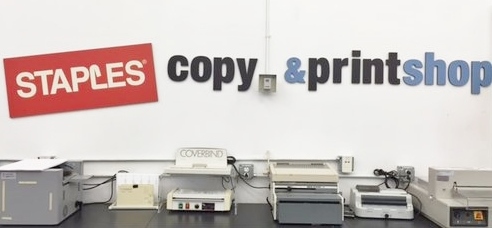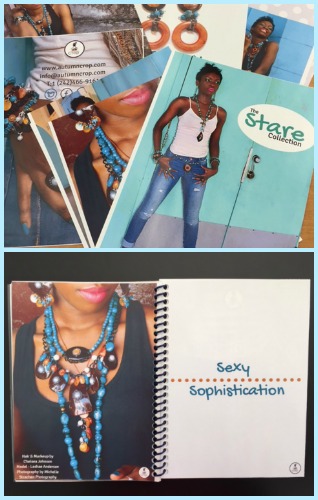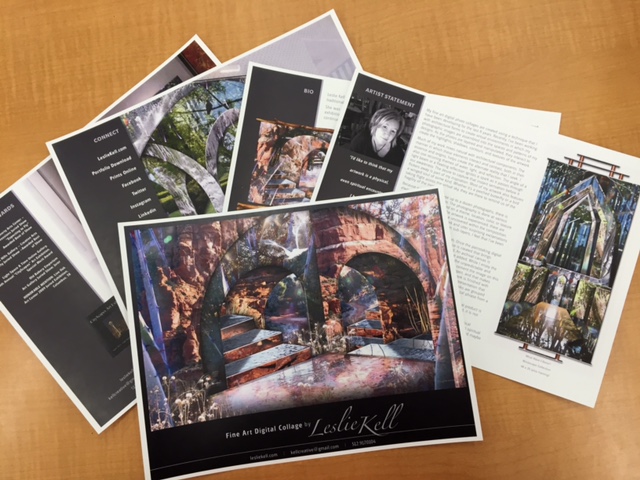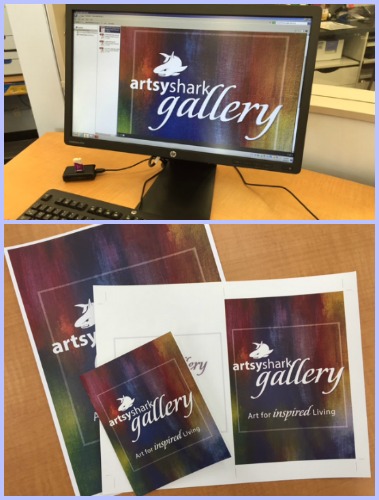by Carolyn Edlund
Can artists use copy and print services when promoting themselves and their work? Absolutely! Here are a few ideas to get you started.

Staples invited me to write a sponsored post about these services, which are provided in every one of their stores. So I put together three projects to demonstrate the power of “hard copy” marketing. Then I headed down to my local Staples store. I met with Linda, the Print & Marketing Production Supervisor there, and here’s what we created:

Lookbook Project
Bahamian jewelry artist Chelsea Johnson sells a collection of smokin’ hot big and beautiful fashion accessories. She has an online lookbook with professionally-shot images of her designs and models wearing her jewelry. Digital is great, being easily accessible and can be sent in a flash. But, it must be viewed on a computer or device. Hard copies add another dimension to Chelsea’s marketing mojo.
Linda and I printed out the lookbook, choosing a glossy 24 lb. paper. We constructed a bound booklet with a clear plastic cover and Executive binding. It was custom-cut to 5” x 7” (the size of a greeting card) which makes it light and portable. This would be the perfect sales aid to give to a hot prospect at a wholesale trade show. You could also share it with the press or even retail customers at a fashion show or publicity event. There is real value and staying power in distributing physical promotional materials. They have lasting power over sharing a link to your website that can disappear in a blink. This lookbook is a keeper!

Media Kit Project
Artist Leslie Kell has a spectacular media kit that does a great job with show and tell. The kit explains how she uses a complex technique of digital photo collage to create surreal, fantasy environments. She took the time to compile a professional presentation that will be taken seriously. This puts her in a position to work with art consultants, gallerists and curators.
Leslie’s media kit was also virtual, so Linda and I simply used a flash drive on one of Staples’ computers to view and make decisions about printing a hard copy. We didn’t want to lose any image quality, so we tested a few papers first. Eventually we decided on a 32 lb. cardstock with a matte finish that worked perfectly.
Leslie’s kit is pretty extensive and I didn’t want to bind it. I chose Staples’ Poly Zip Envelope to hold her materials in a clear package that would show her artwork and protect the contents. It even has a zipper, so she could use this as a press kit and include other materials as well. She might add her business card or perhaps even a piece of chocolate to entice press members to take one (yes this simple strategy does work!)

Notecard Project
Having just launched an online gallery, we needed a branded notecard for our artists to write a “thank you” to be included with shipments of artwork to new customers. We wanted to make the unboxing experience even better, and needed a quality folded card with matching envelope. Linda and I took a look at the card on their computer first. We tested a few weights of cardstock to make sure it would be perfect before I placed an order for the cards.
Here was my biggest takeaway of the day: there is real value in working in person with someone who is an expert before you place an order for a printing job! I had originally miscalculated the size of the card. And, our first test produced a pixelated image that just looked bad. We revised the size and came up with a sample that had a crisp image on the right weight of paper. Linda was even able to place an order for me on the store computer for the notecards with matching envelopes to be shipped directly to me.
Using print collateral in your small creative business is a good strategy to enhance your art marketing efforts. It can work effectively with other methods, providing a physical reminder of your collection that has staying power. (Have you ever kept a postcard because you loved the artwork on the front? Others do too.)
Consider how you might be able to use printed materials in your own marketing campaigns.


This was helpful in getting some ideas spurred for my own marketing – thank you!
Lisa, you might check out other articles on this site about printed materials, including these:
http://www.artsyshark.com/2013/04/01/art-notecards/ and http://www.artsyshark.com/2012/02/28/how-artists-can-make-an-effective-press-kit/
Thank you, Carolyn – I will definitely check these out!
Hard copy may seem old fashioned but it still gets the word out!! And gives the potential. patron something to hold on to and share
Very true, Carol! I always recommend that artists use multiple ways to market. They support each other, and give more ways to reach out.
I’ve had a couple people mention that they really enjoyed getting the postcards I send out before shows. One of them then attended the show and bought 3 paintings. Social media is necessary these days but it sure doesn’t replace the “in hand” materials like you said!
Hello Carolyn: I enjoyed your insights thoroughly on this subject! Working with someone on the project certainly makes a huge difference in selecting appropriate materials. Your postcard turned out beautifully!
Shared across the board ?
Thank you for all you do!
I agree, Adriana. After seeing the mockup of the notecard on the first try, it was pixelated and needed to be redone. It really helped to be able to see exactly what the results would be, and also to have the copy & print manager offer to help me place my online order, right in the store!
I have a colleague who insists she ‘throws postcards out’. I remind her that if it’s a dynamic or helpful card (with tips or a calendar), it still has potential to be kept or tacked up, as opposed to solely using an email link which, if it is even opened, disappears into the vast email desert in a millisecond. A tip someone shared: ALWAYS put your url on the front, as well as the back, if they do, in fact, tack it up. It’s one less notion they have to do to find you, and it gets in their head!
C
Your friend may throw postcards out, but many people don’t. I save them, and put them on my fridge, and I am a person who can help artists, refer them and build relationships with them. Don’t discount the number of people who are in this position. You are wise to suggest that the URL goes on the postcard, and it may be appropriate on the front depending on the design.